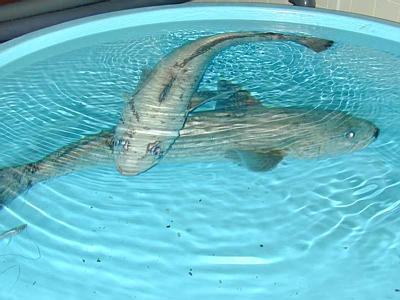3 December, 1999
Another Kind of Fish Story
The Southern circumpolar ocean is considered to include waters higher than
55° South latitude. There is little mixing of waters north of this latitude
thus creating a uniquely isolated ocean with no access to warmer waters. In
looking at past history of the earth, there was a time when the existing
circumpolar ocean did not exist. Instead, there were continents around
which ocean waters moved. When oceans flow around large chunks of land,
there is upwelling of water near the shores and warming of the waters as
well. From our knowledge of plate tectonics, we know that Antarctica was not
always so isolated or cold. But when it became cut off from the great ocean
currents by the circumpolar currents with no continents in the way of the
water, then no warm waters reached the shores of Antarctica, and the cooling
may have begun.
What does this have to do with the fishes? Think about what must have
happened to the fish populations as the waters began to cool and no warm
currents blended with these waters anymore. Many of the invertebrates and
fishes that lived in warm waters did not survive. Here is where you can now
apply your knowledge of genetics and evolution. While most fishes did not
survive the drastic cooling of the ocean around Antarctica, a few did
survive. They were somehow just different enough that when the environment
changed, they had a survival advantage.
As we now study the fishes that live in Antarctic waters, we ask the
question "How are these fish able to survive the sea water that is -2
degrees Celsius?" Dr. Art DeVries form the University of Illinois began to
ask that question more than 30 years ago. He discovered in 1986, that the
freezing point of the blood serum of the Antarctic cod was significantly
lower than that of other fishes. It is -1.8° C to -2.2° C versus -0.7 ° C
for other similar fish in warmer water. The next obvious question is "what
is in the blood serum that allows for liquid at -2°C?" According to Dr.
Chris DeVries, marine bony fishes have their origin in fresh water fishes.
It is the salts in the blood that allow for the lowering of the blood
temperature. This will explain lowering of blood temperature to -0.7°C, but
it does not explain lowering below the freezing point of water.
What problems do the fishes have to solve to avoid freezing in super cooled
waters? How to the fishes prevent entry of ice crystals into their systems?
How do they deal with the crystals that do get into their bodies? There are
two ways for ice to get in the fish body. Ice crystals can be in the food
they eat (smaller fishes) or in the water they drink. (yes, they do drink
water). In both cases, the material goes into the intestine and gets
digested. Where would you start to look for an answer to these questions?
Perhaps in the blood or in the digestive system or both places if you are a
physiologist.
Dr. DeVries found that there is a glycoprotein that acts like antifreeze
preventing the blood from freezing. He found the protein by doing a
dialysis of fish blood and found a large quantity of this protein. The
protein he found basically depresses the freezing point of blood by
inhibiting the formation of ice crystals in body fluids. Another thing he
found is that there is very little of this protein excreted in the fish
urine. This means that the kidneys (and the glomerlus within the kidney)
have adapted to conserving this protein, perhaps as an energy saving
mechanism giving those with the adaptation a survival advantage.
Today the AFGP is found in all of the fishes in the Antarctic waters. If we
think about this from an evolutionary point of view, there was a lot of
space in the super cold waters for the fish with the ability to survive the
cold. Evidence shows that the cod, which is really an Antarctic toothfish,
with AFGP protein probably, evolved 2-3 million years ago. This coincides
with research about the ice age and past climate changes. After the waters
cooled, the surviving fish with some sort of protection from the cold were
able to live, grow and expand their niche in these waters.
As we look at the evolutionary development of the AFGP an interesting
scenario develops. Trypsinogen is a digestive enzyme that has a section in
its genetic makeup that codes for a repeat of a three amino acid sequence
repeat of Thr-Ala-Ala. This is repeated three times in the early part of
the protein. The AFGP protein is a simple protein of Thr-Ala-Ala with four
repeats followed by a spacer and more repeats. A simple amplification in
early individuals could have a survival advantage if that mistake gave them
a protein that would bind to any ice crystals. It is now thought that this
is how the AFGP evolved. Today there are 8 versions of the protein and it
is found in all fishes in these super cooled waters. Each separate species
lives at a different depth, but all have a similar variation of the AFGP. It
also appears that the evolution of AFGP is directly related to climate
change. The Antarctic toothfish appear after cooling and the start of the
ice age. Ask me about the molecular genetics.

Here is some Antarctic cod in the aquarium at the Crary Lab

Here is Chris DeVries who works on the molecular genetics of the antifreeze glycoprotein. she has a theory about the convergent evolution of this protein that has evolved in fist in the arctic seas as well as the Antarctic waters. She found that the similar protein does not have a common ancestor. Evolution has solved the same problem twice in a similar way.
Contact the TEA in the field at
.
If you cannot connect through your browser, copy the
TEA's e-mail address in the "To:" line of
your favorite e-mail package.
|
